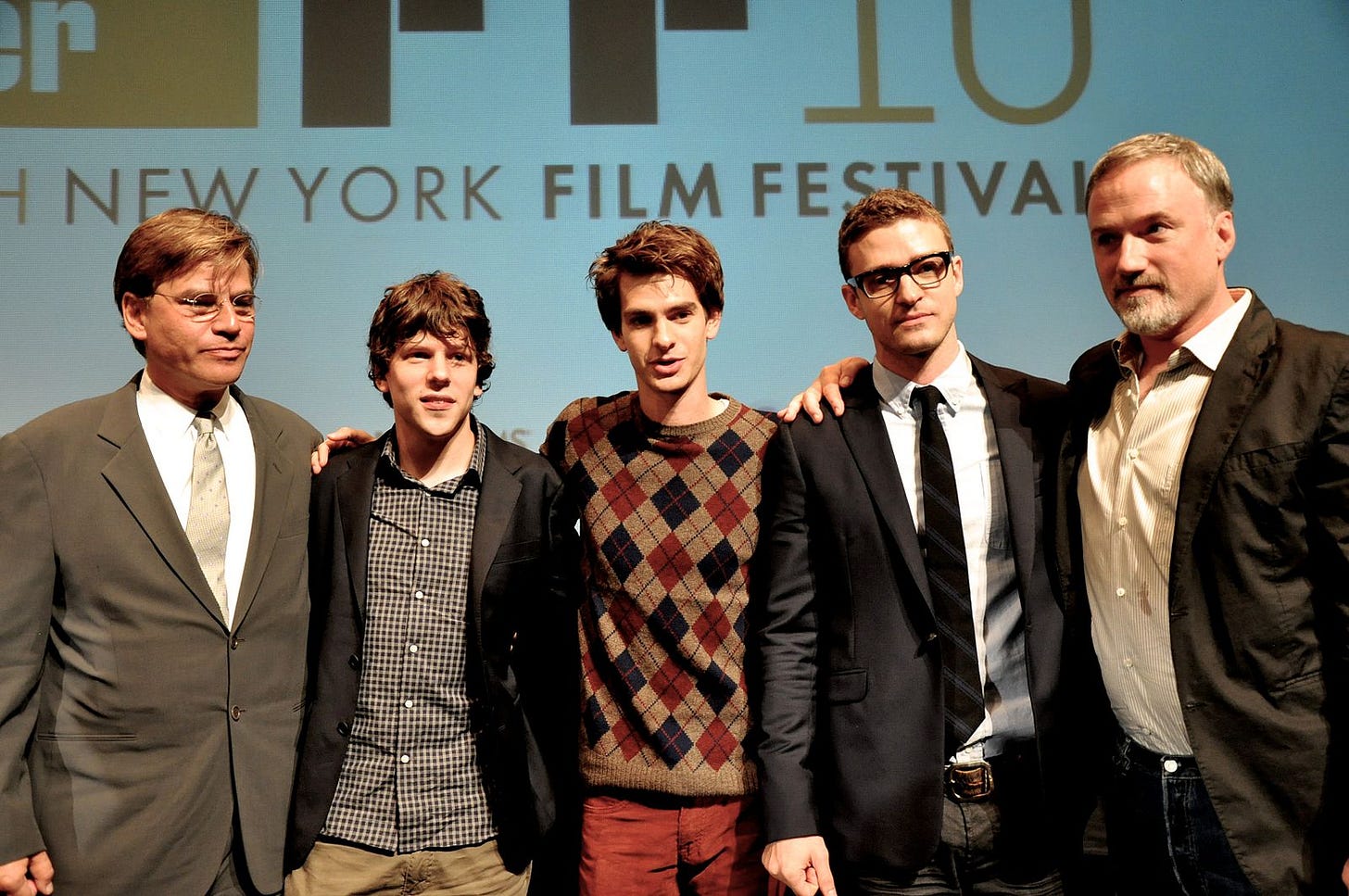The Unholy Alliance of Millennials and Boomers (Florida Man vs. The Substance)
You've got to pump it up! Florida Man reviews Coralie Fargaet's 2024 film The Substance.
NOTE: This piece does include spoilers for the film.
As we enter the twilight of 2024, I have come to the conclusion this year in media has been a very feminine year. The most notable new films that I watched followed female protagonists: Pixar’s Inside Out 2, Sean Baker’s Anora, and now Coralie Fargeat’s The Substance. Heck, even a children’s animated film about robots was about a female robot in Chris Sanders’s The Wild Robot. We are breaking the android glass ceiling, everyone! Rosey the Robot would be so proud of how far we’ve come. Throw out the apron, Rosey! You are now a liberated, modern woman!
In music, the biggest albums came from women: Charli XCX’s Brat, Beyoncé’s Cowboy Carter, and Taylor Swift’s The Tortured Poets Department. Heck, in the United States, we almost elected our first female president! As Chappell Roan has proclaimed, it was truly a Feminomenon!
Amid all these entries to the American media zeitgeist, I do not think that any piece of content will stick with me more than The Substance. On January 1, 2025 — we will have shockingly hit the halfway mark of the 2020s decade, and we can probably start thinking about what defines this strange decade. After watching this film, I have realized that The Substance might encapsulate the 2020s more than any film so far.
Boomers and Millennials Love Each Other
Before I delve into the film itself, I want to explore the toxic relationship between the boomers and the millennials as this film explores that relationship. The characters of both Demi Moore and Margaret Qualley in The Substance embody this duality. The boomers and the millennials have always had a strange alliance and kinship. They might have a performative, superficial antagonism toward each other, but they need each other in a codependent manner.
Yes, the millennials quite literally needed the boomers because the boomers begat the millennials. The boomers birthed them and then raised them. Sure, the shoddy childrearing by the boomers led to thousands of dollars spent on psychotherapy and SSRIs, but wouldn’t you rather be dependent on Prozac instead of not existing at all? You need the boomers! Look at who put a roof over your head! Look at who put food on the table! You better finish your plate! You know there are kids starving in Africa right now, right?
A View into Silicon Valley
Sure, we castigate the boomers as narcissistic, materialistic, and consumerist — but millennials really mirror that narcissism too. It makes sense. The boomers raised them, but the narcissism of the millennials has a shiny veneer of optimism and entrepreneurship! From the Baby Boomer generation, we can think of the founder tech billionaires like Bill Gates of Microsoft or Steve Jobs of Apple. For each of these examples, we have wide-eyed millennial billionaire wunderkind like Mark Zuckerberg of Facebook or Evan Spiegel of Snapchat. The millennial exuberance can even devolve into snake oil salesmanship like Sam Bankman-Fried of FTX or Elizabeth Holmes of Theranos.
In between the generational bookends of Bill Gates and Mark Zuckerberg, their Generation X equivalents of Silicon Valley do not have the same cultural ubiquity even if their inventions made just as much of an impact. We might know their names, but how many people could pick Sergei Brin or Larry Page out of crowd? You see Michael Dell’s monosyllabic surname plastered on so many computer towers and monitors, but do you know what he looks like?
Boomer-Millennial Dichotomy in the Presidential Election
The boomer-millennial synergistic duality even took the spotlight in our 2024 presidential election. Pop quiz! Which presidential ticket had a younger average age? The Republican one or the Democratic one? Well, here’s your shocking answer. The Republican ticket of Donald Trump and JD Vance was younger by a few months. Both Kamala Harris and Tim Walz were born in 1964, technically the final year of the Baby Boom, but I am going to count them as Generation X because they are such a borderline case.
The generational analysis of the two tickets deserves its own article, but why did the Harris-Walz ticket fade into the background and ultimately lose? Why did the Trump-Vance ticket have the memetic power in pop culture? Both Trump and Vance perfectly embody their respective generations while Harris and Walz embody Generation X but from the perspectives of the two genders.
Trump is the apotheosis of the boomer mythos. He brandishes his name in gold across the world. He likes big buildings. He loves McDonald’s while Vance perfectly fits the mold as the first millennial on a major party presidential ticket. JD Vance harkens back to the bootstraps success of a Horatio Algers novel but he wraps it in a facade comfortable for the professional managerial class.
He grew up in a small hillbilly town with a mother addicted to opioids. In his college years, he falls in love with Natalie Portman in the 2004 film Garden State. As a sensitive young man, he needs a manic pixie dream girl like Natalie Portman of the early aughts. JD Vance is Zach Braff. Haven’t you listened to The Shins? Then, Vance follows the PMC’s “rules” and gets into Yale Law School! Yippee! After Yale, he slithers into Silicon Valley to make money with Peter Thiel. In the millennial dreamscape, going to Yale or working with Peter Thiel is the ultimate goal. If you do both of those, maybe you can write a book about it and do a TED Talk to explain why Trump won in 2016.
Silicon Valley and Hollywood
Why do I bring up Hollywood and Silicon Valley? Well, they are the two nodes of global American power in our largest and most prosperous state: California. Silicon Valley in the north provides industrial and technological power while Hollywood in the south provides cultural and social power. The only other two nodes of global power in the United States are DC and New York City.

Nonetheless, I am still writing a review of The Substance here! Hollywood, Silicon Valley, boomers, and millennials actually all tie together. When I think of the relationship between boomers and millennials in cinema, I think of David Fincher’s 2010 film The Social Network. Aaron Sorkin famously wrote the screenplay for The Social Network, for which he earned an Academy Award. We had known Sorkin for over two decades by the point as a progenitor and auteur of boomer fantasy as seen in NBC television series The West Wing, which aired from 1999 to 2006.
The film The Social Network displays for us a love letter from boomers to millennials. Fincher and Sorkin are romanticizing and vicariously living through the exploits and success of the founders of Facebook. This film has all the good tropes of millennials. The rude wunderkind savant on the spectrum with Jesse Eisenberg, the goodhearted entrepreneur in Andrew Garfield, the handsome Lothario in Justin Timberlake, the crazy girlfriend in Brenda Song, and the well-meaning sweet girl next door in Rooney Mara!
Despite all their flaws, Fincher and Sorkin clearly want to live the lives of these millennials at their youth. As boomers themselves, Fincher and Sorkin relate to these youngsters in a way that they could not relate to Generation X. Furthermore, both Fincher and Sorkin could be the fathers of these people. Most importantly, Fincher and Sorkin are projecting themselves onto these millennials. Do not forget. The boomers begat the millennials.
One scene in The Social Network encapsulates this bequest of the future from the boomers to the millennials. Bill Gates (Steve Sires) speaks at Harvard with Mark Zuckerberg (Jesse Eisenberg) and Eduardo Saverin (Andrew Garfield) in the audience. Just as so many of the events in The Social Network, this speech by Gates never occurred. Based on the timing of the film, it would have happened in 2003. Gates did not speak at Harvard until he gave the commencement address in 2007, two years after Zuckerberg had dropped out, yet this scene shows a metaphorical passing of the torch of which Fincher and Sorkin would fantasize. After Eisenberg and Saverin leave the speech, Eisenberg has this exchange with one of their friends:
Bob: You know, I could swear he was looking at you when he said “The next Bill Gates could be right in this room”.
Mark: I... I doubt it.
Bob: I showed up late, I don't even know who the speaker was.
Mark: It was Bill Gates.
Bob: Shit, that makes sense.
Aaron Sorkin ends the scene with Bill Gates with this snappy dialogue between Mark and his friend Bob. As a boomer would want to do, Sorkin puts in the inspirational and optimistic quote “The next Bill Gates could be right in this room”. This quote demonstrates the passing of the torch from Gates to Zuckerberg. Of course, Sorkin still must poke fun at the spacey millennials in the form of Bob, a college student who did not even know that Bill Gates was speaking.

Boomer-Millennial Antagonism in The Substance
In stark contrast with the 2010 film The Social Network, the 2024 film The Substance displays an antagonistic relationship between the millennial and the boomer. As I will describe later, the exact time in which The Substance takes place does not exactly make sense, so the generational categories do not entirely make sense either. I am using the labels of millennial and boomer in a directionally true sense. If we assume that The Substance takes place in the present day of 2024, then Demi Moore’s character Elisabeth Sparkle is not a boomer because she turns 50 years old in the beginning of the film. Therefore, she was born in 1974, a year squarely in Generation X, but Demi Moore herself is a boomer. She was born in 1962.
Consequently, the age discrepancy between Demi and her character Elisabeth introduces in the film a very interesting meta-dynamic. Moore in many ways is playing herself. Many people have discussed the perfect casting choice of Moore in the film. The character Elisabeth is fighting with her age, yet — ironically but likely intentionally — we have a 62-year-old actress in Demi who looks very good for her age. In fact, she is 12 years older than the character whom she portrays in The Substance.
Obviously, in real life, Moore has probably gotten many surgeries and undergoes treatments like Botox, but she still looks very good. Regardless, for the purposes of this article, I am going to count Elisabeth Sparkle as a boomer, and I will count Sue as a millennial since Margaret Qualley was born in 1994, a year that falls within the millennial generation.
Generational Anguish in 2024
As I wrote at the beginning of this article, so many of the new films that I have watched this year follow female protagonists, but the common thread between them does not just stop at the shared gender. Rather, each of these films depicts women in different generational cohorts facing social pressures with identity and perhaps beauty standards in the year 2024.
The Pixar sequel Inside Out 2 came first in June. (I wrote a review on Substack about it as well.) This film follows Riley, a 15-year-old girl who begins puberty and has to deal with new emotions associated with that transition. Riley falls on the boundary between Generation Alpha and Generation Z. She is 15 years old in the film. Therefore, she would be born in 2009, but Generation Alpha technically does not start until the birth year of 2010. The chronology of the Inside Out cinematic universe encounters further complications because the first installment came out in 2015 and depicted an 11-year-old Riley, so the Riley in the 2015 film would be born in 2004. For these reasons, I am going to place Riley from Inside Out 2 on the border between Generation Alpha and Generation Z.
Five months later, in November, I have seen both Anora and The Substance. The former follows the 23-year-old titular woman who works as a stripper and an escort in New York City. Played by Mikey Madison, Anora would have been born in 2001 and falls clearly into Generation Z. The actress Mikey Madison herself was born in 1999. In The Substance, the two main characters embody the Millennials and the Baby Boomers as I have already written. Sue, played by Margaret Qualley, serves as the millennial — and Elisabeth, played by Demi Moore, serves as the boomer.
Beyond Demi Moore, The Substance has even further accurate depictions of boomers with Dennis Quaid’s character, a television producer and executive with the apt name of Harvey. In the still shown above, Quaid is encroaching on Qualley alongside a gang of a gray-haired “shareholders” of the network for which Harvey and Sue both work. Surely, all of these men are at least boomers. Perhaps some fall in the Silent Generation, perched above the Boomers in population pyramid. Nonetheless, they all embody the worst forms of the male gaze, in this case, buttressed by the desire to maximize viewership and profits for their network. Quaid and his cadre of shareholders embody both the pressures of “toxic masculinity” (if we still want to use that term) and materialistic capitalism.
Elisabeth vs. Sue
The millennial-boomer antagonism comes to a head with the resentment between Elisabeth and Sue. Despite the fact that they supposedly share a consciousness, each woman despises the other one. Throughout the film, the people who are giving Elisabeth the “substance” keep reminding her on the phone that “You are one”. This edict only gains more and more potency throughout the film as we see the divide between the two entities grow even further.
Some of the most powerful scenes in the film come whenever either Moore or Qualley is talking on the phone with the shadowy purveyors of the Substance. In one scene, Elisabeth (Demi Moore) will hurl blame at Sue (Margaret Qualley) and vent through the phone, and — in a subsequent scene — Sue will return the blame and lambast Elisabeth. From Elisabeth’s perspective, Sue is stealing time by going over the maximum of seven days in the younger body. As a result, Elisabeth’s body begins to aggressively age.
This aging begins with Elisabeth’s index finger on her left hand turning completely black and bruised. As the film progresses, her body degrades even further. The still above shows Elisabeth with gray hair and even further wrinkles. Elisabeth is now beginning to look like a hag. I know that people keep pointing out The Substance’s clear allusions to Stanley Kubrick’s 1980 horror classic The Shining, but I am also seeing allusions to Disney’s 1937 animated film Snow White and the Seven Dwarfs. In this iteration of Elisabeth, she is beginning to resemble the witch (or the Evil Queen) while Sue resembles the perfect Snow White. I most clearly saw this connection when Elisabeth is cooking from her French cookbook and maniacally yelling at her television, which is showing Sue on a big talk show.
On the other side of the coin, Sue resents Elisabeth too, and she will express her frustrations with those who provide her with the Substance just as Elisabeth does. From Sue’s perspective, she does not just selfishly want to live in the younger and more attractive body. Instead, she no longer wants to have to clean up after Elisabeth’s messes in quite a literal sense. Whenever Elisabeth transitions to Sue, Sue must clean up massive messes that Elisabeth has made in their apartment. Elisabeth indulges in solitary binge eating and leaves food remnants like chicken carcasses all over the place. At a certain point, Elisabeth covers up the entire window overlooking Los Angeles with newspapers so that she could obscure the billboard advertisement for Sue.
These scenes with either Elisabeth or Sue on the phone demonstrate a characteristic antagonism between the millennials and the boomers in contemporary society. The boomer Elisabeth resents Sue for her selfishness and vanity, but Elisabeth also harbors deep jealousy for this younger and more attractive version of herself, who could easily have been her daughter. Sue also embodies what Elisabeth used to be, and Elisabeth can only achieve that status once more by using the Substance, a medical treatment with clearly terrible side effects.
Meanwhile, the millennial Sue sees Elisabeth and literally has to clean up her messes. This resentment from Sue to Elisabeth mirrors a larger resentment that millennials have for boomers. Millennials feel as if boomers have ruined the American experiment for them. Boomers profited from the post-WWII years with cheap houses but led to problems like global warming and the instability of the financial system. The boomers live high on the hog while the millennials in the future will have to pay if they are not paying already.
The irony comes from the fact that the millennials and boomers are often one in the same as I discussed earlier in the article. The millennials and boomers share a certain degree of narcissism, which manifests in different ways. Steve Ballmer is clearly different from Sam Altman. Ballmer buys the Los Angeles Clippers while Altman purportedly wants to make a “difference”. Likewise, Elisabeth and Sue are actually the same person as the mysterious voice on the phone keeps telling them. Whatever time Sue uses beyond the seven days is paid by more accelerated degradation of Elisabeth’s physical form. If we are going to treat them as not distinct entities but rather the same entity, then we will see Elisabeth’s anger at Sue and vice versa as self-hatred. The climatic brawl between the two represents physical self-harm. In the case of chasing unrealistic beauty standards, perhaps this self-harm would manifest in the real world as bulimia, anorexia, or cutting.
Coralie Fargeat could have made a glib and half-baked premise and just blamed this anguish within Elisabeth Sparkle on the problematic men in the film, largely represented by Dennis Quaid’s character Harvey, the television executive who fires Elisabeth Sparkle on her 50th birthday. As Harvey says when he is simultaneously firing Elisabeth and eating shrimp in the most disgusting manner possible, “at 50, it stops”. Instead of placing all the blame on Harvey and the caricatures of the gray-haired shareholders, Elisabeth herself shoulders much of the blame too. She has bought into the materialistic and superficial pressures of Hollywood for a former sex symbol on the screen.
The Ozempic Connection and Eternal Youth in the 2020s
I have many thoughts on this film, but I want to limit myself to opinions that I have not really seen many other places. I am not going to analyze the elements of the body horror genre and how Fargeat explores it in new ways. Rather, I want to end my review by addressing the potential connection to Ozempic. I stated that The Substance might best embody the 2020s out of any film so far. Part of the reason that I make this statement is because of its allusion to drugs like Ozempic.
Of course, for decades, we have had access to routine treatments to reverse aging. We can think of any kind of plastic surgery. Demi Moore herself had very conspicuous plastic surgery at age 34 when she underwent breast augmentation, but we can also point to Botox, which might better resemble the Substance than breast implants because patients receiving Botox must get a new cycle of it every 3 or 4 months. Furthermore, doctors deliver Botox via a syringe just as Elisabeth and Sue administer the green Activator fluid, an integral part of the treatment of the Substance. Similar to the Substance, a patient must maintain her Botox cycles, or the wrinkles will return.
Beyond Botox, the logistics of taking the Substance probably better matches Ozempic or other semaglutide treatments. I show dosages of both Ozempic and Monjauro in the images above. These separate syringes each week match the daily shots that Elisabeth and Sue must administer themselves each day to stabilize. Just as improperly taking the Substance will result in terrible side effects, improper administration of Ozempic can have similar effects.
For one, it can lead to the loss of the wrong weight — such as connective tissue, muscle, or water weight via artificial dehydration — but, if you ever stop it after using it for a while, you can gain back all the weight that you lost and oftentimes more. In other words — in the pursuit of weight loss — you can actually end up fatter than before. Similarly, in the pursuit of eternal youth via her use of the Substance, Elisabeth actually ends up aging in a much more accelerated and repulsive manner.
In the simplest sense, these treatments — either the fictional Substance or the real-life Ozempic — can be counterproductive and backfire. The Ozempic can lead to a similar splitting of the self. There is the you when you overate, and then there is you while you are losing weight in an artificial way. In The Substance, we see the clear divide in the separate bodies of Elisabeth and Sue.
Doctors had prescribed the semaglutide drugs long before 2021, largely for diabetes, but people did not start using them for weight loss in a broad manner until 2021. Ozempic’s prevalence in the public consciousness perhaps came to a head with the South Park special “The End of Obesity” on May 24, 2024. For these reasons, I see The Substance as a film perfectly nested within the 2020s decade. Of course, we will not know the truth of that opinion until we enter the 2030s decade and have full cultural context. Although the struggles with unrealistic beauty standards are not new at all in art, the medicalization of the problem through injectable drugs is new for the 2020s.
In this pursuit of youth, we return to these vague, nebulous solutions. The film calls the treatment the Substance, but we never find out what it actually is or how it actually works. Is it a drug? What is the Activator? What about the ominously black Termination fluid near the end of the film? Where do the bags of the beige food sludge come from?
These vague terms have a long history in the horror film genre: The Blob, The Thing, It, The Stuff, The Shining, etc. We do not necessarily know what these things are, but we have a sense of an omnipresent, villainous force lurking in the metaphorical and literal shadows. Fargeat could have called it whatever she wanted: the Goop, the Slop, the Sludge. Did you take your shots of Goop today? Did you call the shadowy doctor on the phone? Gwyneth Paltrow even sells her beauty product Goop. I’m not sure what it does, but Gwyneth sells it. She’s pretty. It must be good.
The Substance is full of these vague, generic terms. We never get a name of the network. It’s just the Network. The late-night show is just The Show. When Harvey hires Sue, the billboards just say “new show is coming” without any further explanation. The New Year’s show is just the New Year’s show. There’s just a sexy young woman on the billboard, so I will somehow find a way to watch. The shareholders have no name. The only names we get are Elisabeth Sparkle, Sue, and Pump It Up!
As we ascribe magic powers to the Goop or the Substance or whatever, the blame transfers to the person for not taking it. Oh? You’re upset with being fat? Oh. It’s your fault. You’re not taking the Goop? Everyone is taking the Goop. You have heard of the Goop before, right? It’s not hard at all. You just inject the Goop into your belly every week. You want to be younger? Don’t you know there’s a cure for that? It’s called the Substance. With all these treatments, you feel left out when you don’t know of one. Boomers like Elisabeth are entering this new technological world with cure-alls like Ozempic, Botox, or the Substance — and it becomes overwhelming just as the industrial world overwhelmed an anxious Edvard Munch in The Scream. It’s all too much, man.
I wholeheartedly believe that this film will stick with me for a while. This horror film perfectly captures the beauty struggles of the 2020s in a new way while Fargeat pays homage to horror classics such as Stanley Kubrick’s The Shining or David Cronenberg’s The Fly. When you have a problem, you can always just take the Substance. Everyone is doing it.














Cool thoughts!